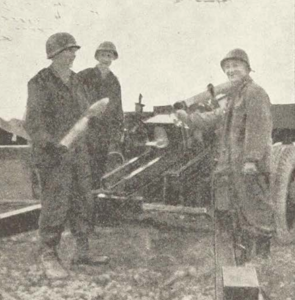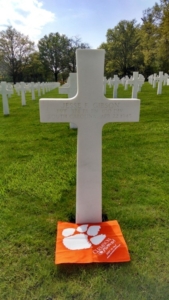Scroll of Honor – Jesse Franklin Gibson
“One of Our Best Boys”
Written by: Kelly Durham
Jesse Franklin Gibson came to Clemson in 1936 from the crossroads community of Centenary. An engineering major, Gibson joined the Swamp Fox Club which had been organized the previous year by the boys from Marion County to provide a social forum to relieve the rigors of cadet life. Gibson was assigned to 2nd Platoon of D Company, 2nd Battalion, 2nd Regiment of the Cadet Brigade. He remained at Clemson only one year before returning to Centenary. Back home, Gibson worked in farming and served as the treasurer of Terrell’s Bay Baptist Church.
Gibson reported for active duty in November 1942, just as America’s fortunes in World War II began to turn. He was assigned to Headquarters Battery of the 374th Field Artillery Battalion, one of the 105 mm howitzer battalions assigned to the 100th Infantry Division.

374th Field Artillery Battalion crew in action.
In September of 1944, Gibson’s battalion moved from its training base at Fort Bragg, North Carolina to Camp Kilmer, New Jersey. It boarded the Hoboken Ferry and crossed to New York’s Pier 44. The battalion loaded its gear and personnel aboard the USAT George Washington for a fourteen day Atlantic crossing to Europe. The ship passed through the Straights of Gibraltar, reaching Marseilles, France on October 20, 1944.
The 374th and its parent 100th Infantry Division, became part of 7th Army and moved north from Marseilles up the Rhone River Valley, reaching its bivouac near Sainte-Hélène on October 29. The battalion was formally committed to combat at Raon l’Etape and began firing its howitzers in support of 100th Infantry Division operations. The battalion continued to support the 100th’s advance as it moved into the rugged Vosges Mountains toward the French-German frontier.
The fast and accurate fire of the 374th’s artillery helped the division beat back a determined German counterattack which commenced on New Year’s Eve 1944. At one point, with flanking units pulling back from the line, the 379th Infantry Regiment was exposed to German attacks from three sides. The 374th’s shelling helped blunt the German attack and enabled the division to hold its positions.
On March 16, 1945, Gibson’s battalion reached the Rhine River. Six days later, it crossed through the vaunted Siegfried Line and into Germany. The battalion continued to advance through what its official history called “beautiful country prostituted by the Nazi Regime,” capturing the towns of Frankenbach and Heilbronn.
On April 22, near the village of Manolzweiler, east of Stuttgart, Germany, Jesse Gibson was killed in an ambush by German  snipers. The 374th Battalion history described him as “one of our best boys.” The following day, the 374th, after a record-setting 178 consecutive days on the line, was pulled out and placed in the 7th Army’s reserve.
snipers. The 374th Battalion history described him as “one of our best boys.” The following day, the 374th, after a record-setting 178 consecutive days on the line, was pulled out and placed in the 7th Army’s reserve.
Private First Class Jesse Franklin Gibson was posthumously awarded the Bronze Star and the Purple Heart. He was survived by his mother, five sisters, and two brothers, one of whom was serving in the Army and the other in the Marines. Gibson was buried at the Lorraine American Military Cemetery in France. A memorial marker was placed in the Centenary Cemetery.
For additional information about Jesse Franklin Gibson see:
https://soh.alumni.clemson.edu/scroll/jesse-franklin-gibson/
For more information about Clemson University’s Scroll of Honor visit:
https://soh.alumni.clemson.edu/
